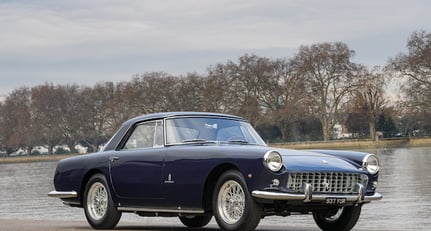1959 Ferrari 250
-
Year of manufacture1959
-
Chassis number1533 GT
-
Lot number120
-
ConditionUsed
-
Location

-
Exterior colourOther
Description
1959 Ferrari 250 GT Series II Coupé
Coachwork by Pininfarina
Chassis no. 1533 GT
By the early 1960s, road car production had ceased to be a sideline for Ferrari and was seen as vitally important to the company's future stability. Thus the 250, Ferrari's first volume-produced model, was critically important, though production of the first of the line - the 250 Europa, built from 1953 to '54 - amounted to fewer than 20. Before the advent of the Europa, Ferrari had built road-going coupés and convertibles in small numbers, usually to special customer order using a sports-racing chassis as the basis. Ghia and Vignale of Turin and Touring of Milan were responsible for bodying many of these but there was no attempt at standardisation for series production and no two cars were alike.
The introduction of the 250 Europa heralded a significant change in Ferrari's preferred coachbuilder; whereas previously Vignale had been the most popular carrozzeria among Maranello's customers, from now on Pinin Farina (later 'Pininfarina') would be Ferrari's number one choice, bodying no fewer than 48 out of the 53 Europa/Europa GTs built. Pinin Farina's experiments eventually crystallised in a new Ferrari 250 GT road car that was first displayed publicly at the Geneva Salon in March 1956. However, the Torinese carrozzeria was not yet in a position to cope with the increased workload, resulting in production being entrusted to Carrozzeria Boano after Pinin Farina had completed a handful of prototypes.
True series production began with the arrival of Pininfarina's 'notch-back' Coupé on the 250 GT chassis, some 353 of which were built between 1958 and 1960 within the sequence '0841' to '2081'. However, the relatively small scale of production meant that cars could still be ordered with subtle variations according to customer choice, as well as enabling a handful of show cars and 'specials' to be constructed on the 250 GT chassis.
A number of important developments occurred during 250 GT production: the original 128C 3.0-litre engine being superseded by the twin-distributor 128D, which in turn was supplanted in 1960 by the outside-plug 128F engine which did away with its predecessor's Siamesed inlets in favour of six separate ports. On the chassis side, four-wheel disc brakes arrived late in 1959 and a four-speeds-plus-overdrive gearbox the following year, the former at last providing the 250 GT with stopping power to match its speed.
More refined and practical than any previous road-going Ferrari, yet retaining the sporting heritage of its predecessors, the 250 GT by Pinin Farina is a landmark model of immense historical significance. Despite this, original survivors are relatively few, as many have been modified and converted into replicas of more exotic Ferraris such as the 250 GTO, Testarossa, etc.
The seventh second-series 250 GT produced, '1533' was delivered new to Giacomo Cuoghi, a resident of Ferrari's hometown of Modena. In February 1967 the Ferrari passed into the ownership of one Andreoli Vittoria and then some two years later to Mr Tom Meade. Quickly sold on, the car went to Rip Martin of Los Angeles on 2nd July 1969, it being noted at the time that a different engine of correct type had been installed (it is still in the car today). The Ferrari was then exported and by 2006 was with Mr William Senyak, reportedly as a restoration project. In 2012 Tom Shaughnessy brought '1533' to the UK where it was comprehensively restored both cosmetically and mechanically by GTB Restorations.
Since completion the Ferrari has been invited to several classic car shows, including the 2017 Warren Concours d'Élégance where its superb quality was acknowledged by a class win, and has also been featured in Classic Cars magazine (February 2018 edition). More recently marque specialists Joe Macari Performance Cars, an official Ferrari service centre in London, have carried out further works (including fitting correct Borrani wire wheels) to achieve the all-important Classiche certification. Handsomely finished in Blu Notte (Dark Blue) with tan Connolly leather interior, this expertly restored 250 GT is worthy of the closest inspection.





































